 |
| February 16, 2021 | Volume 17 Issue 07 |
Designfax weekly eMagazine
Archives
Partners
Manufacturing Center
Product Spotlight
Modern Applications News
Metalworking Ideas For
Today's Job Shops
Tooling and Production
Strategies for large
metalworking plants
Porsche 3D prints electric drive housing
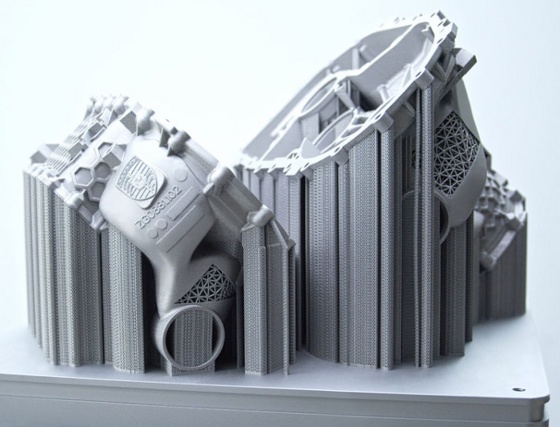
Drive housing prototype for small-series production, 2020. [All images credit: Porsche AG]
High-end vehicle maker Porsche has produced its first complete housing for an electric drive using 3D printing. The lighter, more rigid, and more compact engine-gearbox unit was produced using an aluminum alloy powder and an additive laser-fusion process. It has passed all the necessary quality and stress tests without any problems.
The drive housing was printed on a NXG XII 600 machine made by SLM Solutions. The NXG XII 600, which uses Selective Laser Melting, is equipped with 12 overlapping 1-kW lasers and a build envelope of 600 x 600 x 600 mm.
"This proves that additive manufacturing with all its advantages is also suitable for larger and highly stressed components in electric sports cars," says Falk Heilfort, project manager in the Powertrain Advance Development department at the Porsche Development Center in Weissach, Germany.
Porsche engineers were able to achieve several advancements with the prototype. The alloy housing is lighter than a conventionally cast part and reduces the overall weight of the drive markedly. Thanks to special structures that have only become possible due to 3D printing, the stiffness in highly stressed areas has been doubled. Another advantage of additive manufacturing is that numerous functions and parts can be integrated. This reduces assembly work considerably and directly benefits part quality.
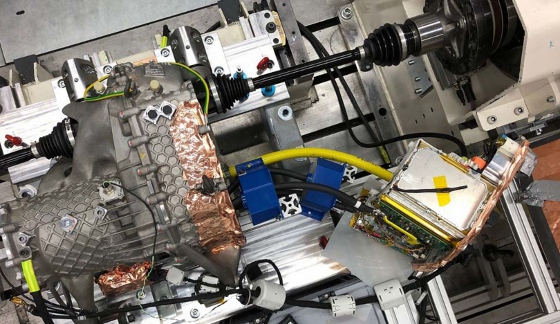
3D printing opens up new opportunities in the development and manufacture of low-volume parts. The new electric drive housing protects both the electric motor and a two-speed gearbox inside, and it is designed for use on the front axle of a sports car. The drive unit measures 590 x 560 x 367 mm and was built in only 21 hours on the NXG XII 600.
Porsche is driving forward the use of additive manufacturing, with an eye on optimizing highly stressed parts in particular. A few months ago, new printed pistons also successfully proved themselves in a 911 GT2 RS high-performance sports car. In that application, piston blanks were 3D printed by TRUMPF and final machining was done by MAHLE.
VIDEO: TRUMPF/MAHLE 3D-printed pistons for the PORSCHE 911 GT2 RS. [Credit: MAHLE]
No other manufacturing process offers as many possibilities and such fast implementation as 3D printing. Design data can be fed to the printer directly from the computer without intermediate steps such as tool making. The parts are then created layer by layer from aluminum alloy powder. Every layer is melted and then fused with the previous layer. This makes it possible to manufacture shapes such as housings with integrated cooling ducts in almost any geometry. The drive housing was manufactured from high-purity metal powder using the laser metal fusion process (LMF). Here, a laser beam heats and melts the powder surface corresponding to the part contour.
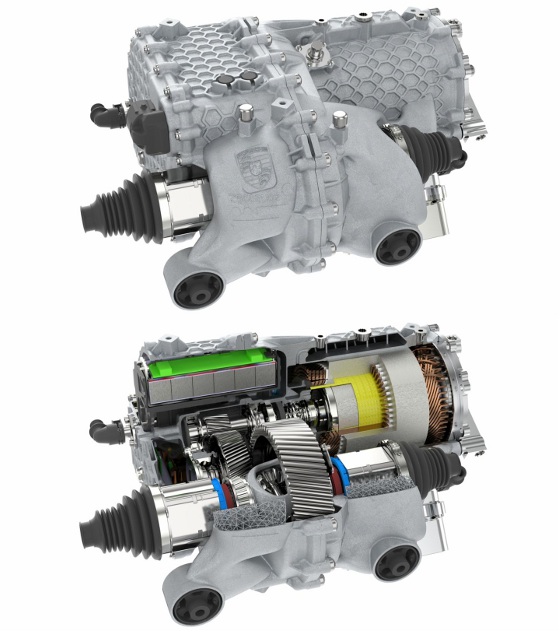
Optimization of the electric drive started with the design integration of components such as bearings, heat exchangers, and oil supply. This was followed by the computer-calculated definition of loads and interfaces. Determination of the load paths then took place.
The next step in the virtual development was optimization of the load paths by integrating built-in lattice structures. These structures take their cue from nature, and can also be seen in similar form in bones or plants, for example.
"We were able to expand and improve our software solutions and methods for creating such parts and are now able to virtually implement them in a very short space of time," says Sebastian Wachter, specialist in Design Methodology and Topology Optimization in the Powertrain Advance Development department at Porsche.
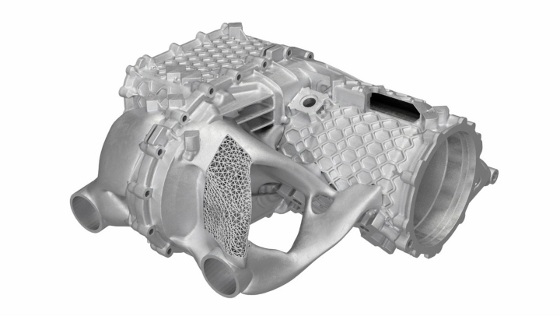
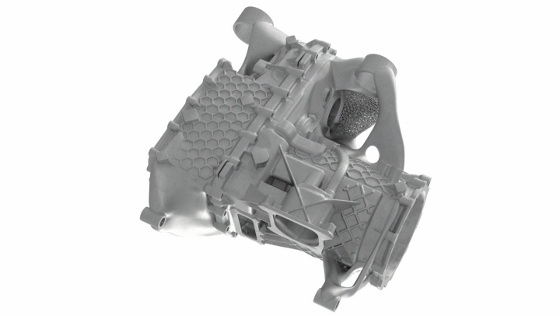
3D printing can impose a need for its own special considerations for specific design requirements, though. Engineers have to take into account that the work pieces are produced layer by layer using fusion. If there are large protrusions in the shape, supporting elements such as ribs may have to be planned. In the case of this housing, they could not extend into media-carrying ducts, so it was important to take into account the direction in which the layers were built up in the design phase.
With the machine technology currently available, printing of the first Porsche housing prototype took several days and two build processes due to the component size. With the latest machine generations, Porsche says it is possible to reduce this time by 90%, and the entire housing can be manufactured in one build process.
Porsche says the weight of the housing parts was reduced by approximately 40% due to the integration of functions and optimization of the topology. This represents a weight savings of around 10% for the entire drive due to the lightweight construction.
The stiffness was increased significantly at the same time. Despite a continuous wall thickness of only 1.5 mm, the stiffness between the electric motor and the gearbox was increased by 100% due to the lattice structures. These honeycomb structures reduce the oscillations of the thin housing walls and improve the acoustics of the drive considerably as a whole.
The integration of parts made the drive unit more compact, significantly improved the drive package, and reduced the assembly work by around 40 work steps. Porsche estimates this is equivalent to a reduction in the production time of approximately 20 minutes, but the company did not give specific details on the amount of time it takes to finish the 3D-printed housing unit due to removal of inherent support structures. An additional benefit was that integration of the gearbox heat exchanger with optimized heat transmission improved the cooling of the drive as a whole, which further increases both the unit and vehicle performance.
Source: Porsche
Published February 2021
Rate this article
View our terms of use and privacy policy
